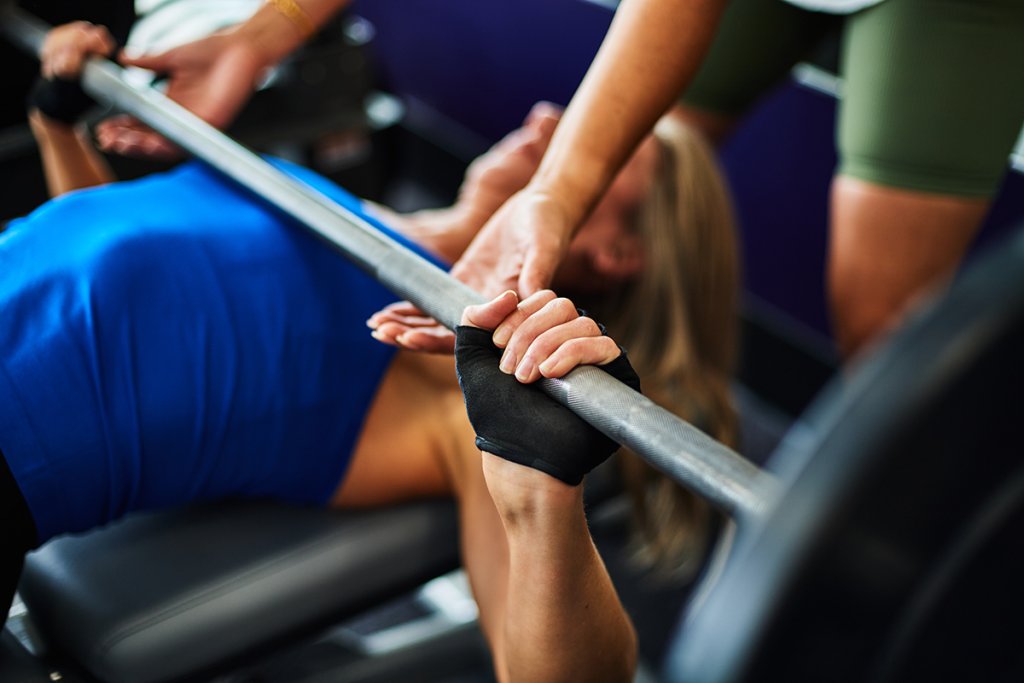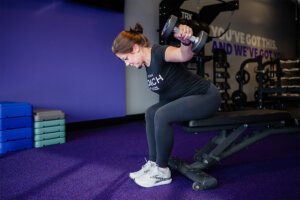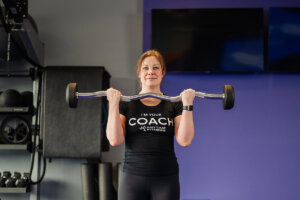“How do I improve my bench press?” It’s a common question for gym beginners and strength enthusiasts alike. When it comes to weight training, there may be times when you feel like you’ve hit a plateau or you want to work toward a new goal.
When it comes to increasing your bench press weight, there are lots of smaller supporting muscles involved, including the triceps, shoulders, shoulder complex, core, and more. These muscles , along with the pectoral (chest) muscles, need to get stronger to improve bench press abilities.
With consistent training, proper bench press form, rest, and nutrition, you can work your way to bigger weights. Below are some tips for building a stronger upper body, including a bench press workout for increasing PRs:
- Barbell Bench Press
- Barbell Incline Bench Press
- Dumbbell Flat Bench Press
- Low Pulley Crossover
Let’s get into it.
The benefits of strength training
Strength training is a critical component of a well-rounded exercise routine — but lifting weights does more than strengthen your muscles. You might not know about the other benefits of weight training, including:
- Higher metabolism
- Stronger bone and muscle mass
- Improved balance and posture, making everyday activities easier
- Improved mood
Benefits of bench press exercises
Bench press workouts are a staple in many strength training routines — it’s a dynamic, functional movement that works several muscles at once, including:
- Front deltoids and pectorals (chest muscles)
- Shoulders
- Biceps
- Triceps
While the bench press is a simple movement, it’s highly effective for strengthening the chest and shoulders — and it can be easily modified to work different muscles with various grips and positions.
How to increase bench press strength: Bench press form
If you’re working toward increasing your bench press weight, having proper bench press form is critical. Even if you’ve been strength training for years, a bench press form check can help you build strength faster, maintain stability, and prevent injury.
1. Positioning on the bench
Find a comfortable position on the bench, so you can easily unrack and rerack the barbell. A good rule of thumb is to keep your eyes directly under the barbell. During the exercise, keep your feet planted on the ground; your head, neck, and shoulders stable; and your upper back and glutes on the bench.
2. Grip and hand placement
Once you have the barbell loaded and are positioned on the bench, knowing how to correctly grip the bar is important. A couple of things to keep in mind:
- Grip the bar in an overhand position, using your thumbs to stabilize the bar as you lift.
- Avoid tucking your thumbs under your fingers.
- Keep your hands slightly further than shoulder-width apart.
Bench press grip types
Varying your bench press grip trains different muscles in your arms, chest, and shoulders. Training bench press with various grips can help improve your overall strength and reduce your risk of injury. There are several variations:
- Wide grip: The wide grip is well suited for lifting heavier weights and increases chest activation to improve your bench press.
- Close grip: The close grip is a narrower grip that emphasizes your triceps and upper chest muscles.
- Reverse grip: With a reverse grip, you’ll flip your hands so your palms are facing behind you. If you struggle with shoulder, elbow, or wrist pain, the reverse grip may help.
- Neutral grip: In a neutral grip, your palms face one another inward. This grip requires an untraditional barbell or dumbbells and can also help reduce joint pain.
3. Technique and movement
Once you’re in position on the bench and ready to start lifting, follow these steps to complete the movement with proper bench press form:
- Grip the barbell with an overhand grip.
- Drive your feet into the ground and brace your core, then unrack the barbell.
- Lock your elbows, positioning the barbell directly above your chest.
- Lower the barbell toward your chest with control, pausing when it touches your chest.
- Slowly push the bar back up to the starting position.
- Repeat the exercise for the desired number of reps.
How to increase bench press strength
One key to improving the bench press is by gradually increasing our weight lifted over time.
But how do you know when you’re strong enough to increase your bench press weight? There is no set formula in knowing when to increase your weights, but a personal trainer can help you work through it. It’s also important to regularly reflect on how you feel after lifting. If you notice you have another couple reps left in the tank after hitting the rep range, increase the weight selection of the following set.
Bench Press Workout for Bigger PRs
This workout features four exercises to increase bench press weight:
- Two barbell bench press exercises
- One dumbbell bench press exercise
- One cable exercise
For the first barbell bench press exercise, use a weight that will challenge you but allow you to complete the full number of reps.
For all the other exercises in this bench press workout, choose a weight that will allow you to reach failure on the first set, then keep the weight the same (even if you can’t reach the rep range on consecutive sets). This will allow your body to adapt and get stronger for your next workout.
1. Barbell Bench Press
This bench press workout starts with the classic barbell bench press (because practice makes perfect).
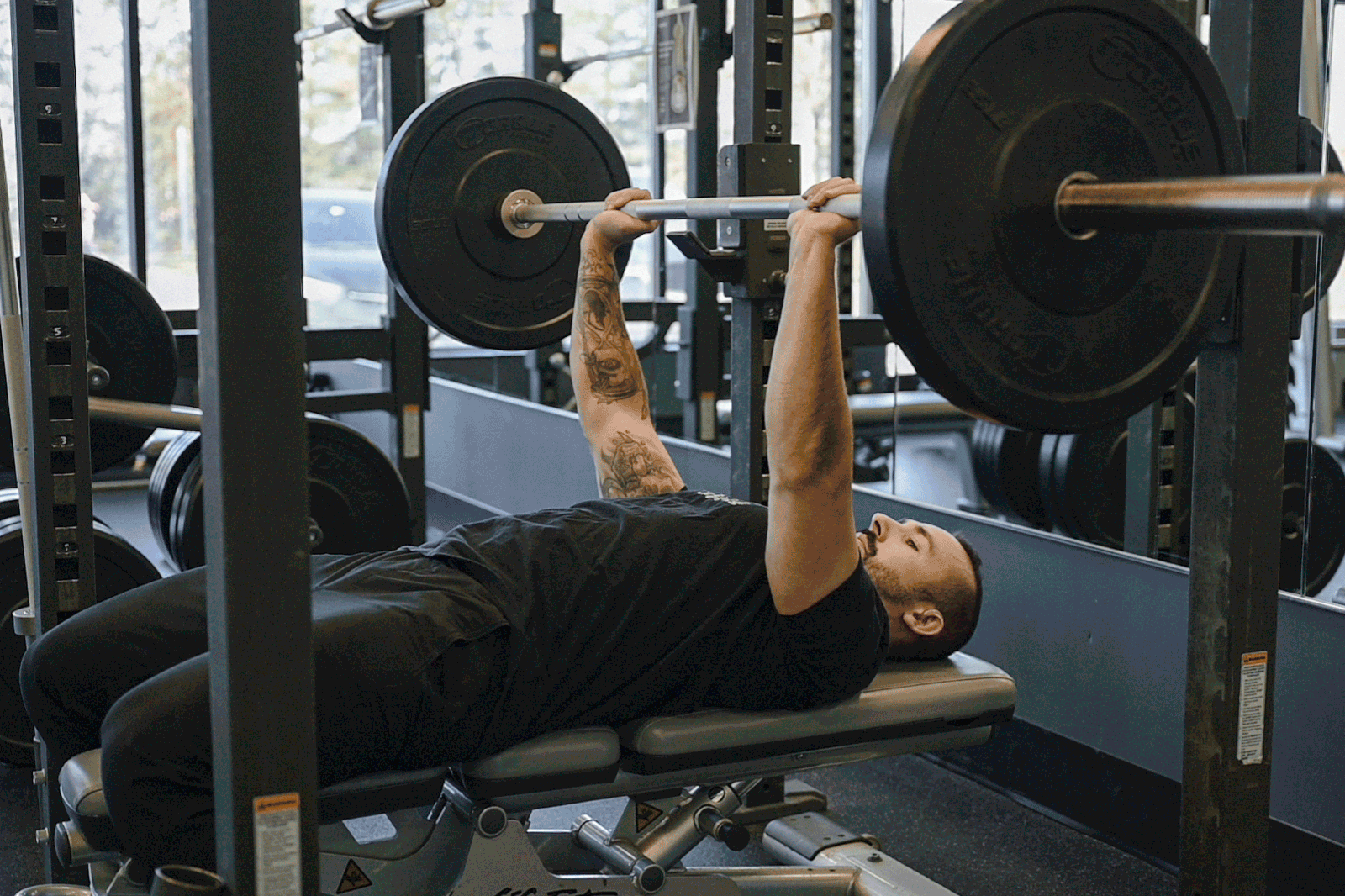
How to:
- Lie on your back on a flat bench and grip the barbell with an overhand grip. Unrack the barbell.
- Lock your elbows, positioning the barbell directly above your chest.
- Lower the barbell toward your chest with control, pausing when it touches your chest.
- Slowly return the barbell to the starting position.
- Perform 5 sets of 5 reps.
2. Barbell Incline Bench Press
The barbell incline bench press works the front deltoid muscles in your chest more than the traditional flat barbell bench press.
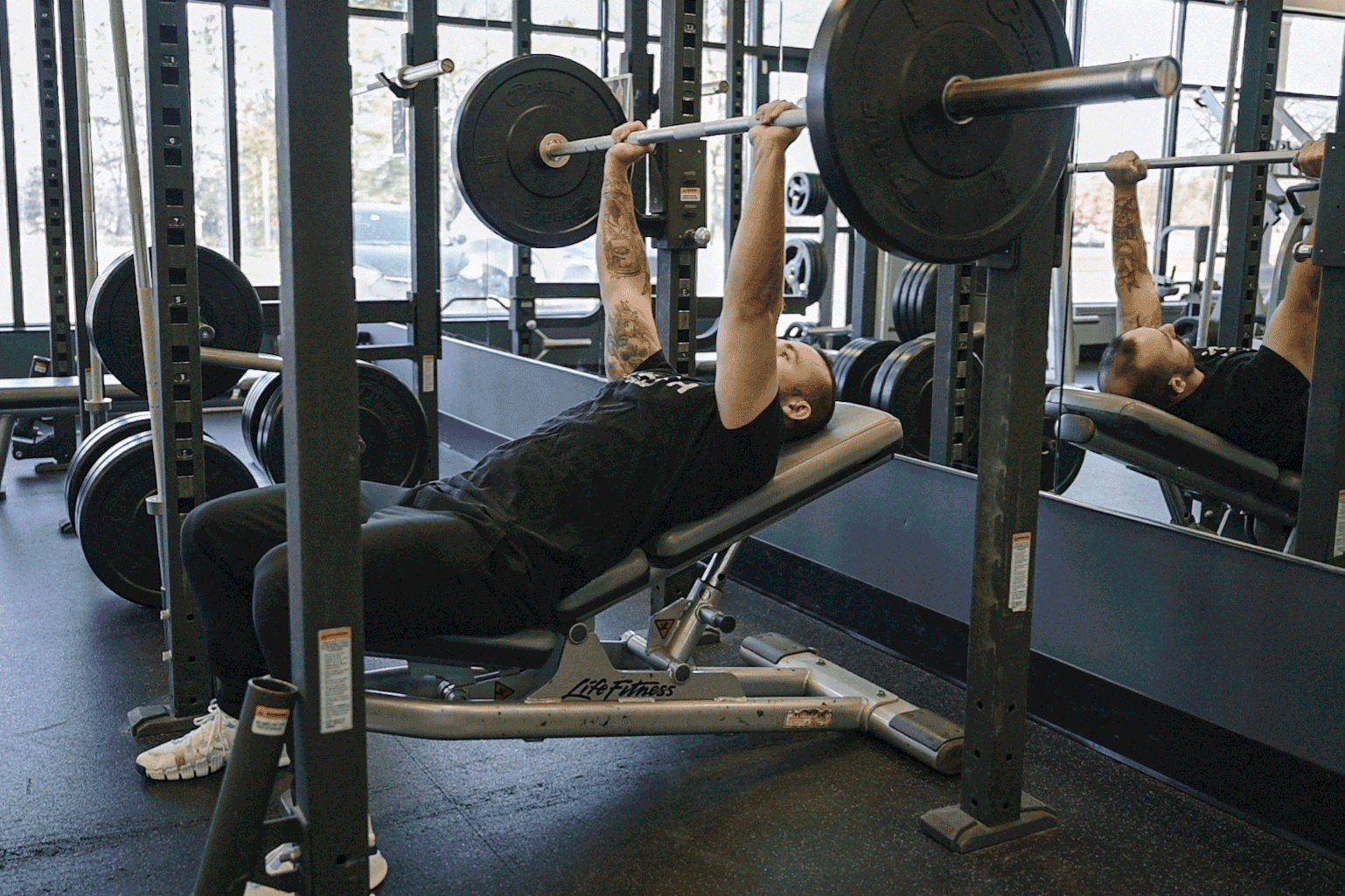
How to:
- Place an incline bench below the barbell, keeping the barbell in line with your eyes.
- Place your feet firmly on the floor and grip the barbell with an overhand grip.
- Unrack the barbell and keep your back flat on the bench.
- Slowly lower the barbell, pausing when it touches your chest.
- Raise the barbell back to the starting position with control.
- Perform 3 sets of 6 reps.
3. Dumbbell Flat Bench Press
Dumbbell bench press exercises require your body to use more of your arm, chest, and shoulder muscles to maintain stability than traditional barbell bench press exercises.
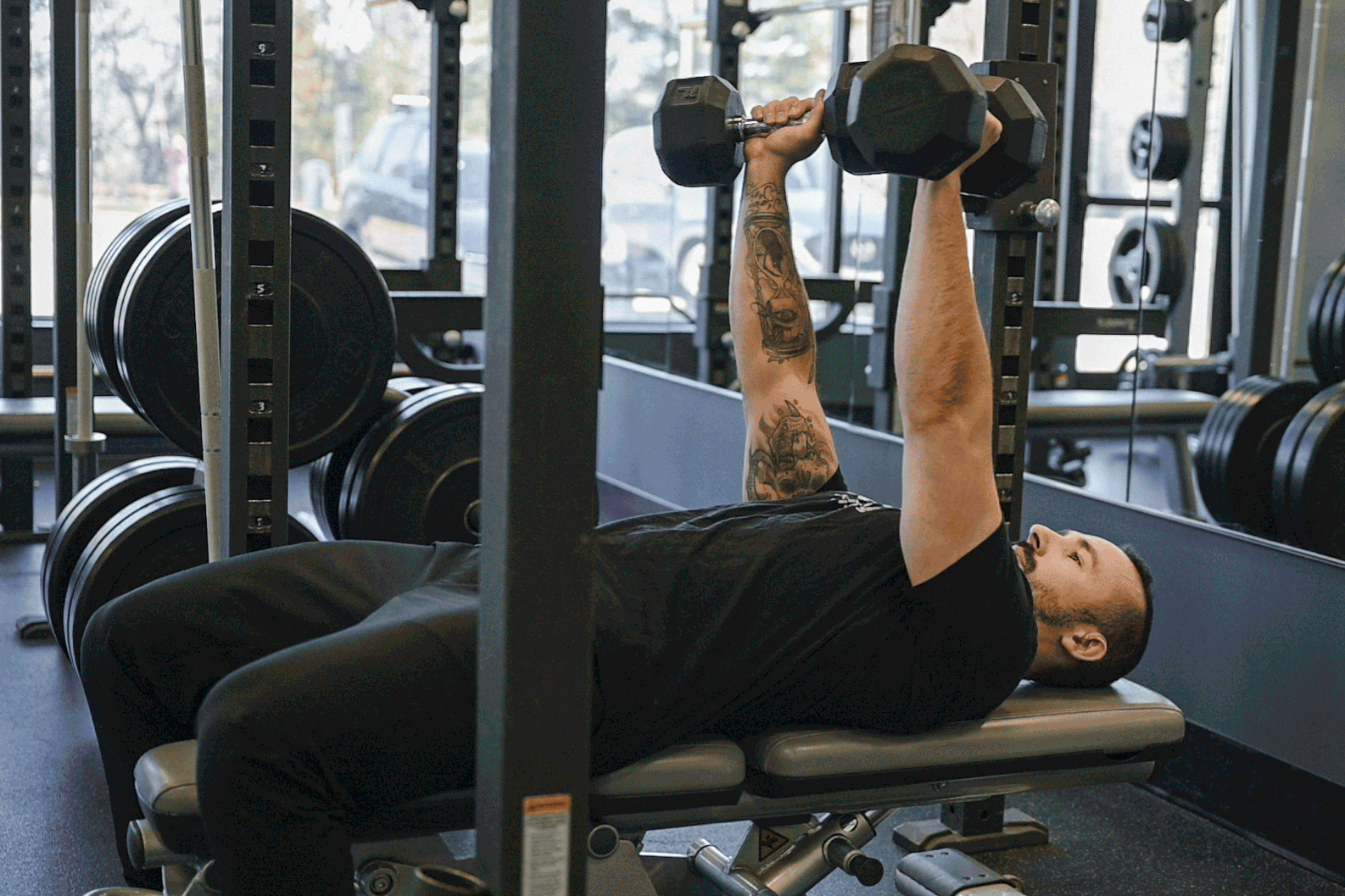
How to:
- Lie on a flat bench with your elbows tucked at your sides and dumbbells at chest level.
- Slowly raise the dumbbells straight up, keeping your feet on the ground and your back against the bench.
- With control, lower the dumbbells back down to chest level.
- Perform 3 sets of 6 reps.
4. Low Pulley Crossover
The low pulley crossover challenges your biceps and triceps, as well as your core, chest, and back muscles.
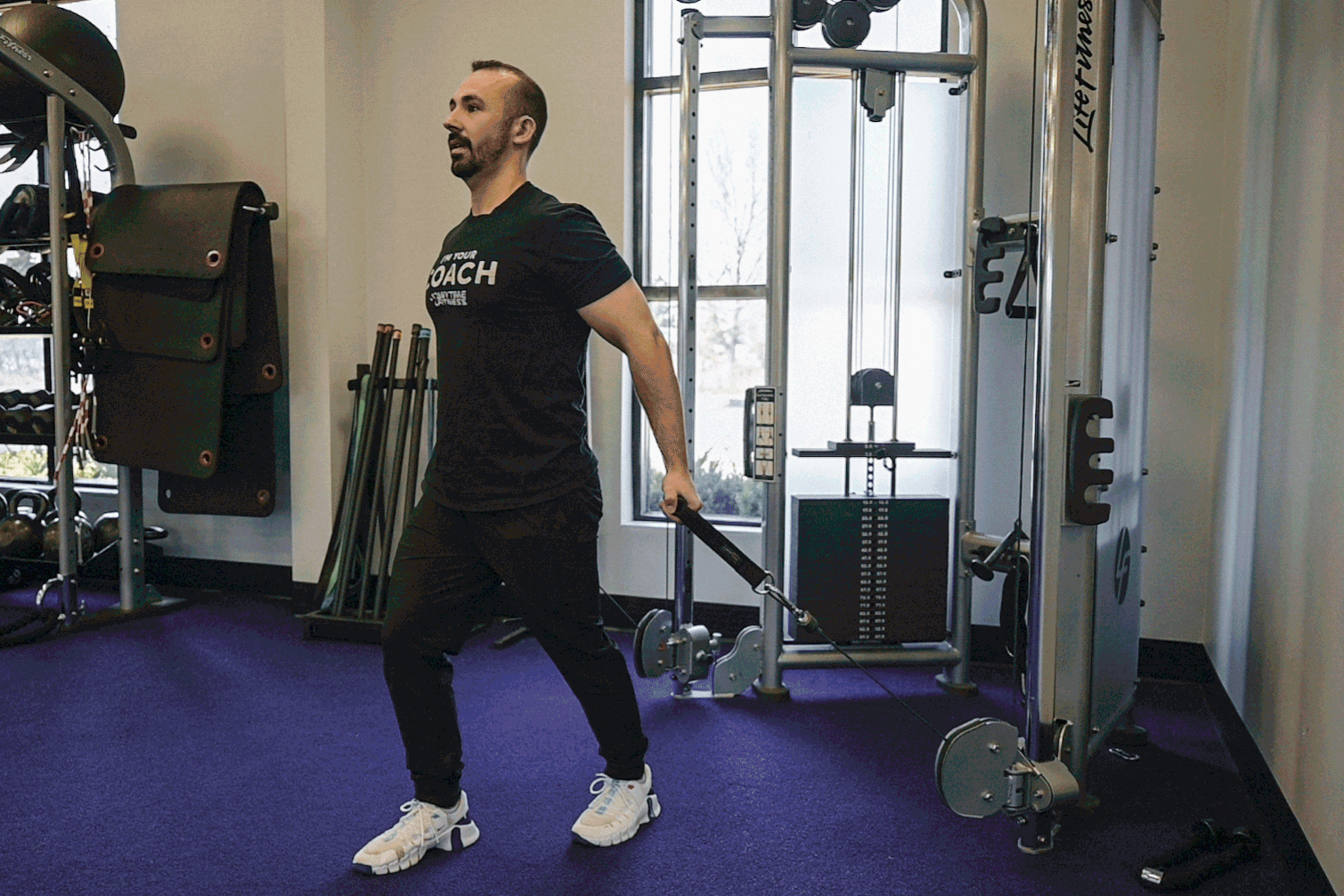
How to:
- Attach a pulley grip to either side of the cable machine and lower them to the bottom of the rack.
- Set your weight with the pin.
- Stand in a split stance and hold one grip in either hand, keeping your arms behind your body and bracing your back and core.
- Using an underhand grip, slowly raise the pulleys forward to shoulder height, keeping your core and lower body stable.
- Slowly lower the pulleys back to the starting position.
- Perform 3 sets of 8 reps.
How to avoid overtraining muscles
If you’re wondering how to increase bench press weight, it’s also essential to understand the importance of muscle recovery and rest days.
While it can be tempting to train every day and skip cooldowns, muscle growth happens during the recovery phase — not during the workout itself. Your body needs time to repair microtears in muscle that happen during a lift in order to build strength. Overtraining can cause stress and strain that increases your risk of pain or injury (and can prevent you from reaching your goal weight).
Incorporating active recovery into your workout split can actually help you achieve your goals faster.
Active recovery: How to increase bench press
Active recovery activities like yoga, stretching, light cardio, walking, and foam rolling help:
- Speed up muscle recovery
- Reduce lactic acid buildup that can cause soreness
- Increase blood flow
- Keep motivation up and prevent mental and physical burnout
A final note on how to increase your bench press
Remember that exercises to increase bench press won’t work overnight and the process looks different for everyone. Most importantly: Listen to your body and be patient with yourself. The journey to bigger bench press PRs is a reward on its own.
Team up with an Anytime Fitness Coach to get more expert advice on how to increase bench press PRs, workout splits, nutrition tips, and more. Get started with your free 1-hour session with a Coach.

Coach Mike Voorhees, NASM-CPT, FNS
Coach Mike found his passion for helping people working as a Coach at Anytime Fitness five years ago. Since then, he’s guided hundreds of people toward their fitness goals. Mike’s coaching philosophy resonates on and off the purple turf as he strives to help you become a stronger and more fulfilled version of yourself.
Mike received his Masters in Exercise Science from Concordia University, St. Paul. He is NASM CPT & FNS-certified and an ISSA Exercise Recovery Specialist. Other certifications include corrective exercise, pain-free performance, TRX training, kettlebell training, and more.
